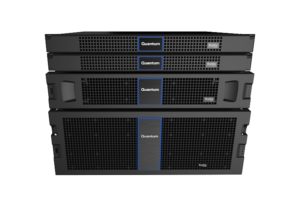
Quantum Corp. today announced a new animation and visual effects workflow reference architecture built on the company’s award-winning Xcellis, the high-performance shared storage system. This robust and exceptionally flexible architecture delivers optimal storage capabilities for animation and editorial operations, thereby streamlining workflows and boosting overall efficiency and productivity. Quantum will demonstrate the new architecture at the SIGGRAPH 2016 Conference and Exhibition, July 24-28, in Anaheim, California (booth 575).
Resolving Collaboration Challenges in Animation/VFX and Editorial Workflows
The time- and resource-consuming task of transferring content between the animation and editorial departments over a network is a key obstacle for post facilities seeking to maximize workflow efficiencies. In some cases, entire facilities must essentially shut down for hours each day as they copy material over the network and dedicate storage systems on both sides of this divide to writing and reading data. Quantum’s new reference architecture enables users to overcome these challenges, maintaining storage for both animation/VFX and editorial within a single shared environment that supplies the type and degree of connectivity required across the end-to-end workflow.
Enabling Greater Flexibility and Efficiency With a Single Storage Platform
Boasting a unique architecture that integrates key workflow storage components into an easy-to-manage, highly scalable hardware solution, Xcellis supports both Fibre Channel and Ethernet clients, hosts workflow applications and manages data across multiple storage tiers. Powered by Quantum’s StorNext platform, Xcellis also allows users to optimize any of up to 64 separate file systems to meet the performance requirements of different departments. These characteristics provide a host of benefits to post facilities that share media across animation and editorial departments, including:
• Storage of all media files on a single system with a single namespace, eliminating the cost of managing and maintaining multiple storage silos.
• Ethernet-based NAS and DLC access, providing the speed and availability animators need, while direct Fibre Channel connections supply the editorial department with highly predicable performance for demanding high-resolution content.
• Render farms that can connect to storage for direct access to content during rendering, eliminating the need for bulk data dumps and network shutdowns.
• Fast, easy and cost-effective system scaling through the simple addition of more storage, making it easy to accommodate growth and new technologies.
Accelerating Operations With QXS Hybrid Flash-Disk Storage
The new Xcellis-based architecture incorporates QXS hybrid disk-flash storage with Q-Tier technology, providing animators with the random I/O performance they need for a fraction of the cost of an all-flash solution. To optimize system performance, QXS Q-Tier technology scores, scans and sorts data every five seconds and moves it between flash and spinning disk tiers as access patterns change.
Integrating Seamlessly Into Media Environments
Because Quantum’s StorNext-powered workflow storage solutions are already certified with leading applications including the Autodesk suite, Adobe suite and animation management tools such as Shotgun, facilities can seamlessly integrate the new reference architecture into existing environments. As a result, users on the animation and editorial sides of the business can continue working with their preferred software tools while realizing a notable increase in performance and much improved ability to work collaboratively.
“Quantum’s new animation and visual effects workflow reference architecture leverages our StorNext-powered Xcellis high-performance storage and QXS hybrid flash-disk storage with real-time tiering to enable much greater efficiency at post facilities with both animation and editorial departments. It not only eliminates the need for separate storage silos but also eases collaboration across these departments and optimizes storage and media access according to the needs of each. With the resulting gains in capacity and productivity, media facilities can take on larger and more demanding projects, and more projects overall.” said Dave Frederick, senior director of media and entertainment, Quantum.





